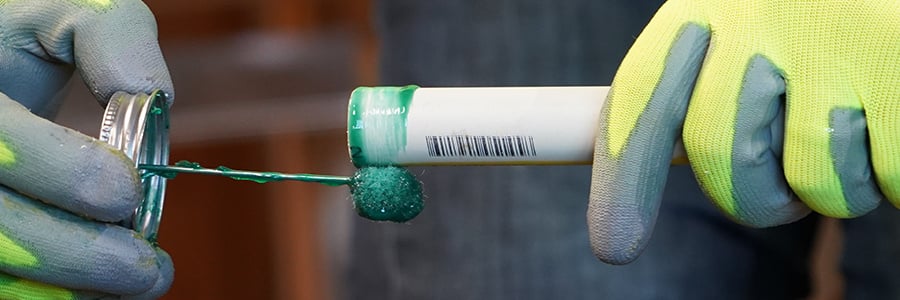
By: Jonathan Simon on July 23rd, 2024
How to Avoid Dry Fits
Contractors | Installation | residential plumbing | CPVC
FlowGuard Gold CPVC plumbing systems are similar to copper in regard to system design. Like copper, CPVC pipes are inserted into the fitting. This prevents the excessive pressure losses that occur in PEX plumbing systems when the fitting is inserted into the pipe, narrowing the diameter of the pipe at the fitting. While copper pipe is joined via soldering, FlowGuard Gold CPVC uses a different, stronger and more permanent method – solvent welding – to join pipes and fittings.
Joining CPVC Pipes and Fittings
With CPVC, the fitting socket is tapered, so that the outer diameter of the pipe is slightly larger than the inside diameter at the bottom of the fitting, creating an “interference fit” that presses the two pieces together firmly to ensure the strength of the solvent weld.
When installing FlowGuard Gold CPVC, it’s recommended to test the interference fit by sliding the pipe into the fitting. You should feel some resistance before bottoming out the pipe, which indicates a proper fit. Then, remove the pipe, apply the solvent cement to the pipe and fitting, and re-insert the pipe until it bottoms out in the fitting, rotating the pipe ¼ to ½ turn to ensure solvent cement coverage.
When the cement cures, the pipe and fitting are fused into one continuous piece of CPVC, creating a joint that is the strongest part of the system. The step-by-step instructions for installing FlowGuard Gold CPVC can be found here.
Now here’s the thing every plumber should know about installing CPVC: the friction between the pipe and fitting in a tight interference fit can hold for a long time at pressures above 100 psi without being solvent welded. That means if a joint in the system isn’t solvent welded, the system can still pass a pressure test. Over time, natural movement and stress on the system will cause an unwelded joint to fail. These dry-fit installation errors are extremely rare but can be very frustrating because the failure may occur after the building is occupied.
One key to avoiding dry-fit failures is to visually inspect the joints after they are complete, and the FlowGuard Gold team has launched a new High Contrast Green Solvent Cement to make it easier than ever to visually inspect a FlowGuard Gold plumbing system. As of 2024, green solvent cement for copper tube size CPVC is accepted by all major model plumbing codes.
There is another important step to avoiding dry-fit failures that can actually speed up the already fast and easy FlowGuard Gold installation process. Instead of pre-assembling the entire system and then coming back through with solvent cement, contractors that weld each joint as it is assembled can eliminate dry-fit failures while saving time with the more efficient process. For added peace of mind, some contractors have their plumbers initial joints with a Sharpie® marker after they are welded as an extra quality check. While this isn’t a required step, it can significantly improve quality control on a jobsite.
The Professional Plumbers Choice
Regardless of whether you’re working with PEX, copper or CPVC, improperly joining fittings to pipes will create a failure. FlowGuard Gold CPVC joints are so inherently strong that even when improperly installed they can, for a period of time, withstand test pressures that would cause other systems to leak. So, make it a habit to solvent weld each joint as it is assembled and visually inspect each joint following system installation.
FlowGuard Gold CPVC is easy to work with, installs fast and results in a clean, professional installation that showcases the plumber’s craftsmanship. The system also helps elevate the trade by building the skills professional plumbers have relied on for decades. To learn more about the benefits of FlowGuard Gold CPVC, download our brochure.


